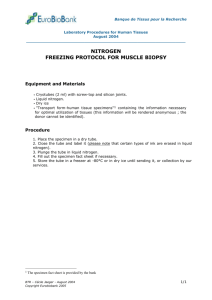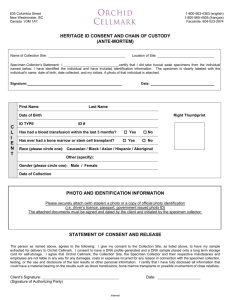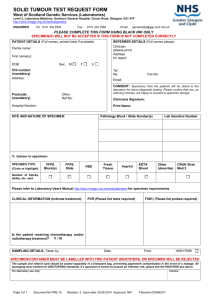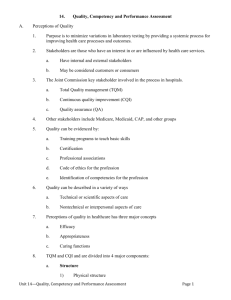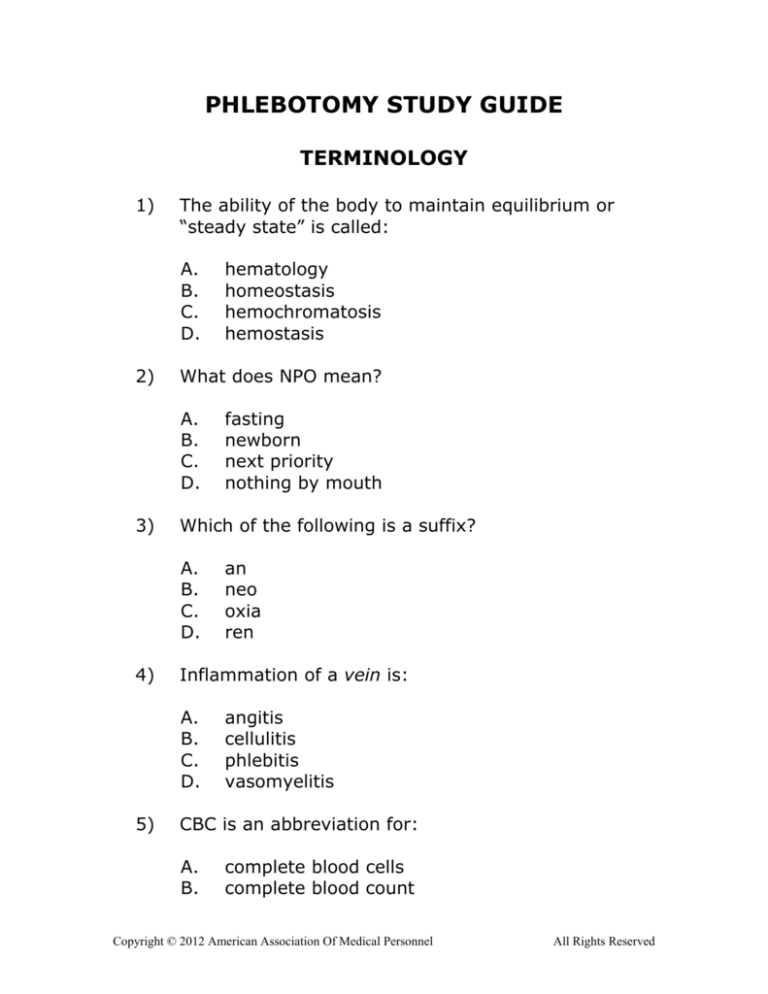
PHLEBOTOMY STUDY GUIDE
TERMINOLOGY
1)
The ability of the body to maintain equilibrium or
“steady state” is called:
A.
B.
C.
D.
2)
What does NPO mean?
A.
B.
C.
D.
3)
an
neo
oxia
ren
Inflammation of a vein is:
A.
B.
C.
D.
5)
fasting
newborn
next priority
nothing by mouth
Which of the following is a suffix?
A.
B.
C.
D.
4)
hematology
homeostasis
hemochromatosis
hemostasis
angitis
cellulitis
phlebitis
vasomyelitis
CBC is an abbreviation for:
A.
B.
complete blood cells
complete blood count
Copyright © 2012 American Association Of Medical Personnel
All Rights Reserved
C.
D.
6)
Which of the following terms means muscle pain?
A.
B.
C.
D.
7)
cell
earth-like
oxygen
red
The abbreviation PT stands for:
A.
B.
C.
D.
9)
atrophy
myalgia
osteomyelitis
tendonitis
The word root “erythro” means:
A.
B.
C.
D.
8)
cerebrospinal blood count
cerebrospinal blood cells
partial thromboplastin
patient temperature
prothrombin time
phenylketonuria
What word means “controlling blood flow?”
A.
B.
C.
D.
hemolysis
hemostasis
homeostasis
venostasis
10) In the clinical laboratory, the abbreviation CSF is
used for:
A.
B.
C.
D.
clinical serum fluid
cerebrospinal fluid
cerebral serum fluid
clinical spinal fluid
Copyright © 2012 American Association Of Medical Personnel
All Rights Reserved
LAB SAFETY
1) In which instance could an electrical shock to a patient
most likely occur?
A.
drawing a patient’s blood during an electrical
storm
drawing a patient’s blood while standing in a
puddle of water
drawing blood from a patient who is talking on the
telephone
touching electrical equipment while drawing a
patient’s blood
B.
C.
D.
2.
Which is not true of disinfectants? Disinfectants are:
A.
B.
C.
D.
3.
If a health care provider is in an area of the health
care facility where a fire starts, she or he should
first:
A.
B.
C.
D.
4.
corrosive chemical compounds
safe to use on human skin
used to kill pathogenic microorganisms
used on surfaces and instruments
attempt to extinguish the fire, using the proper
equipment
pull the lever in the fire alarm box
close all the doors and windows before leaving
the area
block the entrances so that others will not enter
the fire area
What are the major principles of self-protection from
radiation exposure?
Copyright © 2012 American Association Of Medical Personnel
All Rights Reserved
A.
B.
C.
D.
5.
Primum non nocere comes from the Hippocratic oath
and means:
A.
B.
C.
D.
6.
rescue, alarm, confine, extinguish
rescue, activate, cover, extinguish
run, alarm, counter, extinguish
run, activate, confine, escape
Disinfectants are:
A.
B.
C.
D.
8.
first do no harm
first things first
quality is foremost
ready to serve
What does the National Fire Protection ssociation
(NFPA) codeword RACE mean?
A.
B.
C.
D.
7.
distance, combustibility, and shielding
time, distance, and shielding
anticorrosive, shielding, and distance
combustibility, anticorrosive, and distance
chemicals that are used to inhibit the growth
and development of microorganisms but do not
necessarily kill them
used frequently on skin
chemicals that are used to remove or kill
pathogenic microorganisms
quaternary ammonium compounds
If an electrical accident occurs involving electrical
shock to an employee or a patient, the first thing
that the health care worker should do is:
A.
B.
move the victim
shut off electrical power
Copyright © 2012 American Association Of Medical Personnel
All Rights Reserved
C.
D.
9.
start CPR
place a blanket over the victim
Airborne precautions require the phlebotomist to
wear:
A.
B.
C.
D.
a mask
a gown
eye protection
an N95 respirator
10. It is important for the phlebotomist to visually
inspect the needle tip before inserting it in a
patient’s vein to:
A.
B.
C.
D.
check for the presence of bacteria
check the needle point for imperfections that
might damage the patient’s vein
ensure that the bevel is down during insertion
make certain that the needle is not outdated
11. Which of the following is a required characteristic of
a sharps container?
A.
B.
C.
D.
bright red or orange in color
leak-proof and puncture-resistant
marked with a biohazard symbol
all of the above
12. The first step in giving mouth-to-mouth resuscitation
is to:
A.
B.
C.
open the airway by checking for obstructions
listen and feel for return of air from the victims
mouth
determine whether the victim is conscious by
gently shaking the victim and yelling, “Are you
okay?”
Copyright © 2012 American Association Of Medical Personnel
All Rights Reserved
D.
look for the victim’s chest to rise and fall
13. If a chemical is spilled onto a health care worker, she
or he should first:
A.
B.
C.
D.
rub vigorously with one hand
wait to see whether it starts to burn the skin
rinse the area with a neutral chemical
rinse the area with water
14. For safety in the health care facility, which of the
following should not occur?
A.
B.
C.
D.
needles, syringes, and lancets should be
disposed of in a special sturdy container
liquid waste should be discarded rapidly
the specimen collection area should be
disinfected periodically according to the clinical
laboratory schedule
the patients’ specimens should be covered at all
times during transportation
15. Mixing equipment from different manufacturers can
result in:
A.
B.
C.
D.
improper needle fit
needle coming unscrewed
tubes popping off
all of the above
BLOOD COLLECTION TECHNIQUES
1.
Why are gauze pads rather than cotton balls considered
a better choice for covering the site while holding pressure
following venipucture?
Copyright © 2012 American Association Of Medical Personnel
All Rights Reserved
A.
B.
C.
D.
2.
The evacuated tube system requires:
A.
B.
C.
D.
3.
lavender top, SST, royal blue top
gold top, yellow top, light blue top
light blue top, green top, lavender top
red top, gray top, light blue top
An acceptable blood smear:
A.
B.
C.
D.
5.
a special plastic adapter, a syringe, and an
evacuated sample tube
an evacuated sample tube, a plastic adapter,
and a double-pointed needle
a double-pointed needle, a plastic holder, and a
winged infusion set
a special plastic adapter, an anticoagulant, and
a double-pointed needle
Identify the tubes needed to collect a complete blood
count (CBC), partial thromboplastin time (PTT), and
STAT potassium by color and in the proper order of
collection for a multi-tube draw.
A.
B.
C.
D.
4.
gauze pads are more sterile
gauze pads create more pressure
cottons balls are not as absorbent
cotton fibers tend to stick to the site
covers the entire surface of the slide
forms a bullet shape
has a feathered uniform edge
is short and thick
For newborns, the penetration depth of lancets for
blood collection must be:
A.
3.0 mm or less
Copyright © 2012 American Association Of Medical Personnel
All Rights Reserved
B.
C.
D.
6.
Blood collected in a red stopper tube:
A.
B.
C.
D.
7.
heparinized Natelson tube
BD Unopette
Butterfly needle
BD Microtainer
All of the following tube stopper colors indicate the
presence (or absence) and type of additive in the
tube EXCEPT:
A.
B.
C.
D.
9.
may be used for most coagulation tests
will not clot
yields plasma and cells
yields serum and clotted red cells
Which of the following is a commonly used
intravenous device that is sometimes used in the
collection of blood from patients who are difficult to
collect blood by conventional methods?
A.
B.
C.
D.
8.
2.8 mm or less
2.6 mm or less
2.4 mm or less
green
lavender
light blue
royal blue
Proper finger puncture technique includes all of the
following EXCEPT:
A.
B.
C.
D.
avoid squeezing or vigorous massaging
puncture parallel to the whorls of the
fingerprint
puncture the middle or ring finger
wipe away the first drop of blood
Copyright © 2012 American Association Of Medical Personnel
All Rights Reserved
10. Which of the following procedures does not require
cleansing the blood collection site with povidoneiodine solution?
A.
B.
C.
D.
therapeutic drug monitoring collection
arterial blood gas collection
blood culture collection
blood donation collection
11. What do you do if the patient’s physician is in the
room and the specimen is ordered STAT?
A.
B.
C.
D.
ask the patient’s nurse what to do
come back later when the physician has gone
politely introduce yourself, explain why you are
there, and ask permission to proceed
say “Excuse me” and proceed to collect the
specimen
12. In which instance is needle recapping recommended?
A.
B.
C.
D.
after collecting a specimen in a syringe
after collecting a specimen in the emergency
room
after collecting blood gases
recapping is never recommended procedure
13. The following tests have all been ordered at the
same time on different inpatients. There is only one
phlebotomist on duty. Which test should the
phlebotomist collect first?
A.
B.
C.
D.
ASAP CBC in oncology
Hemoglobin in labor and delivery
Timed blood cultures in ICU
STAT electrolytes in the emergency room (ER)
Copyright © 2012 American Association Of Medical Personnel
All Rights Reserved
14. You need to collect blood cultures, a gray top, and a
lavender top on an adult with difficult veins. Which
specimens can be collected by skin puncture?
A.
B.
C.
D.
all of them
blood cultures and gray top only
gray top and lavender top only
none of them
15. Which of the following is true concerning skin
puncture on an infant compared with the dorsal hand
venipuncture procedure?
A.
B.
C.
D.
It is less stressful for the infant
There is less dilution of the specimen with
tissue fluid
Hemolysis occurs more often
Fewer punctures are required
16. It is not a good idea to collect a CBC specimen from
a screaming infant because the:
A.
B.
C.
D.
platelets are more likely to clump
specimen will be hemoconcentrated
specimen will be more likely to hemolyze
white blood count may be falsely elevated
17. Why should a laboratory report form indicate the fact
that a specimen has been collected by skin
puncture?
A.
B.
C.
D.
for liability and insurance purposes
some test results may vary depending on the
source of the specimen
so that subsequent specimens will be collected
by skin puncture also
so that the patient’s nurse can check the site
for signs of infection
Copyright © 2012 American Association Of Medical Personnel
All Rights Reserved
18. Which of the following analytes is significantly
increased in the blood with changes in position?
A.
B.
C.
D.
iron
cortisol
glucose
testosterone
19. A vein may collapse because the:
A.
B.
C.
D.
tourniquet is applied too tightly
tourniquet is too close to the venipuncture site
tube vacuum is too much for the size of the
vein
any of the above
20. You have no choice but to draw a specimen from a
site with a hematoma. Where should you obtain the
specimen?
A.
B.
C.
D.
distal to the hematoma
in the area of the hematoma
proximal to the hematoma
none of the above
21. Identification of an inpatient can best be
accomplished by which of the following?
A.
B.
C.
D.
number on the hospital bracelet and verbal
confirmation from the patient
hospital room number and bed assignment
confirmation from a patient’s relative
none of the above
22. A phlebotomist has attempted twice to draw a partial
thromboplastin time on a patient with difficult veins.
Both times the phlebotomist has been able to draw
Copyright © 2012 American Association Of Medical Personnel
All Rights Reserved
only a partial tube. What should the phlebotomist
do?
A.
B.
C.
D.
collect the specimen by skin puncture
have another phlebotomist attempt to draw the
specimen
pour the two tubes together and mix well
send the tube with the most blood to the
laboratory with a note that it was a difficult
draw
23. Where should the tourniquet be placed on the
patient during the venipuncture procedure?
A.
B.
C.
D.
1 inch above the venipuncture site
Over the venipuncture site
3 inches above the venipuncture site
3 inches below the venipuncture site
24. You may have to be careful about what type of
equipment is brought into the room if a patient is
severely allergic to:
A.
B.
C.
D.
adhesive bandages
latex
perfume
any of the above
25. Excessive or blind probing for a vein can cause:
A.
B.
C.
D.
diurnal variation
lipemia
nerve damage
petechiae
26. If a blood collection site continues to bleed after 5
minutes:
Copyright © 2012 American Association Of Medical Personnel
All Rights Reserved
A.
B.
C.
D.
bandage the site and tell the patient to hold
pressure over the bandage
notify the patient’s physician or nurse
wrap a pressure bandage around the site
none of the above
27. When collecting blood in a syringe, blood should be
placed in the specimen tubes in the correct order to
minimize contamination or clotting, The
recommended order is:
A.
B.
C.
D.
coagulation tubes, anticoagulated tubes, then
blood culture tubes
blood culture tubes, coagulation tubes, other
anticoagulated tubes, tubes without
anticoagulant additives
tubes without anticoagulants, blood cultures,
coagulation tubes
none of the above
28. A phlebotomist must collect a hemoglobin on a
patient in the intensive care unit. There is an IV in
the patient’s left arm. There is no suitable
antecubital vein or hand vein in the right arm. What
should the phlebotomist do?
A.
B.
C.
D.
ask another phlebotomist to collect the
specimen
attempt to draw a hand vein below the IV
collect the specimen by skin puncture of a
finger of the right hand
draw the specimen from an ankle vein
29. What is the advantage of using a butterfly?
A.
B.
C.
blood flow is increased
butterflies are less expensive
butterflies make it easier to draw difficult veins
Copyright © 2012 American Association Of Medical Personnel
All Rights Reserved
D.
there is a greater choice of needle sizes
30. A vein that feels hard and cord-like and lacks
resiliency may be:
A.
B.
C.
D.
an artery
collapsed
superficial
thrombosed
LAB MATH
1)
Normal adult blood volume is 70 mL per kilogram.
You weigh 130 lb. What is your blood volume?
A.
B.
C.
D.
2)
If room temperature is 77o F, what is the
temperature in centigrade?
A.
B.
C.
D.
3)
1300 mL
1.3 L
59 kg
4.1 L
20
25
32
37
A blood culture bottle containing 45 mL of media
require a 1:10 dilution of specimen. How much
blood should be added?
A.
B.
C.
4 mL
5 mL
8 mL
Copyright © 2012 American Association Of Medical Personnel
All Rights Reserved
D.
4)
One teaspoon is approximately:
A.
B.
C.
D.
5)
AM
PM
AM
PM
.8
.08
.008
.0008
What does 2.2 pounds (lb) equal in the metric
system?
A.
B.
C.
D.
8)
1:30
3:30
5:30
7:30
If a red blood cell is 8 µm in diameter, what is its
size in millimeters?
A.
B.
C.
D.
7)
1 mL
5 mL
10 mL
15 mL
Your requisition says that a specimen is to be drawn
at 1530. What time would that be in 12-hour time?
A.
B.
C.
D.
6)
10 mL
1 kg
44 g
100 g
454 kg
200 µL is equal to:
A.
B.
C.
2 mL
0.2 mL
0.02 mL
Copyright © 2012 American Association Of Medical Personnel
All Rights Reserved
D.
9)
0.0002 mL
10 cc of blood equals approximately:
A.
B.
C.
D.
1 mL of blood
5 mL of blood
10 mL of blood
There is no relationship between cc and mL
10) 1.2 kg is equal to how many grams?
A.
B.
C.
D.
12
120
1200
12,000
11) A test requires 3 mL serum. The laboratory requires
that the amount of blood collected be 250% of the
volume of specimen required to perform the test.
Which size tube should you use to collect the
specimen?
A.
B.
C.
D.
4 mL
5 mL
10 mL
15 mL
12) Normal infant blood volume is 100 mL per kilogram.
Calculate the approximate blood volume of a baby
who weighs 6 lb.
A.
B.
C.
D.
1.2 L
2.7 L
270 mL
600 mL
13) To prepare 100 mL of a 1:10 dilution of bleach, add:
Copyright © 2012 American Association Of Medical Personnel
All Rights Reserved
A.
B.
C.
D.
1 mL water to 100 mL bleach
1 mL bleach to 99 mL water
10 mL bleach to 90 mL water
10 mL water to 100 mL bleach
14) One inch is equivalent to:
A.
B.
C.
D.
1 cm
1 mm
5 cm
2.54 cm
15) The civilian equivalent of 1448 is
A.
B.
C.
D.
2:48 AM
2:48 PM
12:48 PM
4:48 PM
16) In the metric system, a millimeter is:
A.
B.
C.
D.
1/10 meter
1/100 meter
1/1000 meter
1/10,000 meter
17) One gallon is equivalent to:
A.
B.
C.
D.
5L
4L
3.78 L
1L
18) The military equivalent of 10:16 AM is:
A.
B.
C.
1016
01000
0116
Copyright © 2012 American Association Of Medical Personnel
All Rights Reserved
D.
10:16
19) A patient voids 1200 mL of urine for a creatinine
clearance test. How much urine is this?
A.
B.
C.
D.
less than a liter
less than a quart
more than a liter
more than 2 liters
20) Which of the following symbols represents one cubic
millimeter?
A.
B.
C.
D.
mmm
cu mm or mm3
mL
mM
INFECTION CONTROL
1)
Which of the following has the highest prevalence of
nosocomial infections?
A.
B.
C.
D.
2)
urinary tract infections
dermal infections
respiratory tract infections
wound infections
The main purpose of an infection control program is
to:
A.
B.
C.
determine the source of communicable
infections
isolate infectious patients from other patients
prevent the spread of infection in the hospital
Copyright © 2012 American Association Of Medical Personnel
All Rights Reserved
D.
3)
Which of the following is an example of an
engineering control that helps eliminate hazards
posed by bloodborne pathogens?
A.
B.
C.
D.
4)
B.
C.
D.
stand back so that clothing does not touch the
sink
wet hands with water before applying soap
wash for at least 15 seconds
turn the faucet off with the towel used to dry
your hands
Which of the following chemicals should be used to
disinfect tourniquets and items contaminated with
blood?
A.
B.
C.
D.
6)
gloves
laboratory coat
sharps container
universal precautions statement
Which is not proper hand washing procedure?
A.
5)
protect patients from outside contamination
70 percent isopropyl
1:10 dilution of chlorine bleach
Hydrogen peroxide
Iodophors
What is the proper way to dispose of laboratory
specimens and contaminated supplies, other than
sharps, when following BSI?
A.
B.
C.
D.
double bag and throw in the trash
place in labeled biohazard bags or containers
place in puncture-resistant containers
throw in trash that is to be incinerated
Copyright © 2012 American Association Of Medical Personnel
All Rights Reserved
7)
The manufacturer must supply a material safety data
sheet (MSDS) for:
A.
B.
C.
D.
8)
Which of the following is the most important
procedure in the prevention of disease transmission
in health care institutions?
A.
B.
C.
D.
9)
fluid-resistant laboratory coats
most patient medications
isopropyl alcohol
isotonic saline
use of personal protection equipment
use of appropriate waste disposal practices
hand washing
reporting personal illnesses to supervisor
The two organizations responsible for the latest
Guideline for Isolation Precautions in Hospitals are
the:
A.
B.
C.
D.
Centers for Disease Control and Prevention
(CDC) and Hospital Infection Control Practices
Advisory Committee (HICPAC)
Centers for Disease Control and Prevention
(CDC) and Occupational Safety and Health
Administration (OSHA)
Hospital Infection Control Practices Advisory
Committee (HICPAC) and National Institute for
Occupational Safety and Health (NIOSH)
National Institute for Occupational Safety and
Health (NIOSH) and Joint Commission on
Accreditation of Healthcare Organizations
(JCAHO)
10) Which of the following is proper neonatal ICU blood
drawing procedure?
Copyright © 2012 American Association Of Medical Personnel
All Rights Reserved
A.
B.
C.
D.
keep your blood drawing tray as close to the
isolette as possible
never awaken an infant to draw blood
use povidone-iodine to clean a skin puncture
site
wear mask, gown, and gloves
11) Under the new CDC isolation guidelines, the old
categories of isolation and disease-specific
precautions have been collapsed into three sets of
precautions that include:
A.
B.
C.
D.
airborne, droplet, and contact
airborne, respiratory, and contact
enteric, contact, and respiratory
complete, droplet, and airborne
12) Gloves are worn to:
A.
B.
C.
D.
prevent contamination of hands when handling
blood or body fluids
reduce the chance of transmitting
microorganisms on the hands of personnel to
patients during invasive procedures
minimize the possibility of transmitting
infectious microorganisms from one patient to
another
all of the above
13) A person who has recovered from a particular virus
and has developed antibodies against a particular
virus is said to be:
A.
B.
C.
D.
a carrier
immune
infectious
susceptible
Copyright © 2012 American Association Of Medical Personnel
All Rights Reserved
14) All of the following are proper laboratory safety
procedures EXCEPT:
A.
B.
C.
D.
secure long hair away from the face
never eat, drink, or apply makeup in the
laboratory
wear closed-toe shoes
wear your laboratory coat at all times
15) Which of the following is not an example of possible
“parenteral” means of transmission?
A.
B.
C.
D.
drinking contaminated water
getting stuck by a needle used on a patient
with AIDS
rubbing the eye with a contaminated hand
touching infectious material with chapped
hands
16) A factor that increases a host’s susceptibility in the
chain of infection is:
A.
B.
C.
D.
drug use
an immunization
use of disposable equipment
proper nutrition
17) The “right to know” law primarily deals with
A.
B.
C.
D.
electrical safety
first aid procedures
hazardous materials information
universal precautions
18) All of the following can be transmitted through blood
transfusion EXCEPT:
A.
diabetes mellitus
Copyright © 2012 American Association Of Medical Personnel
All Rights Reserved
B.
C.
D.
hepatitis B virus (HBV)
human immunodeficiency virus (HIV)
syphilis
19) What precautions are to be used for a patient who
has an enteric pathogen?
A.
B.
C.
D.
airborne
contact
droplet
standard
20) What is the proper order for putting on protective
clothing?
A.
B.
C.
D.
gloves first, then gown, mask
gown first, then gloves, mask
gown first, then mask, gloves
mask first, then gown, gloves
last
last
last
last
21) What should the phlebotomist do if the outside of a
patient specimen tube has blood on it?
A.
B.
C.
D.
discard it after pouring the contents into a clean
tube
discard it in the patient’s room and draw a new
tube
place a biohazard label on it
wipe it with disinfectant
22) All of the following are required parts of an exposure
control plan EXCEPT:
A.
B.
C.
D.
an exposure determination
communication of hazards
isolation guidelines
methods of implementation
Copyright © 2012 American Association Of Medical Personnel
All Rights Reserved
23) The most frequently occurring laboratory-acquired
infection is:
A.
B.
C.
D.
hepatitis A virus (HAV)
hepatitis B virus (HBV)
human immunodeficiency virus (HIV)
tuberculosis (TB)
24) Which of the following involves possible exposure to
bloodborne pathogens by a “percutaneous” exposure
route?
A.
B.
C.
D.
getting stuck with a contaminated needle
handling blood specimens with ungloved, badly
chapped hands
ingesting infectious material
mucous membrane contact with infectious
material
25) Which of the following is not a component that
makes up the chain of infection?
A.
B.
C.
D.
mode of transmission
source
mode of transportation
susceptible host
PROFESSIONAL ETHICS
1)
A patient is told that she must remain still during
blood collection or she will be restrained. Which tort
is involved in this example?
A.
B.
C.
assault
battery
fraud
Copyright © 2012 American Association Of Medical Personnel
All Rights Reserved
D.
2)
When a health care provider gives aid at an accident,
he or she is usually protected through:
A.
B.
C.
D.
3)
“I do not know what you mean”
“I have no idea how long it will take”
“I understand how you must be feeling”
“I’m on a tight schedule right now”
Before a patient’s laboratory test results can legally
be released, the patient must:
A.
B.
C.
D.
6)
younger than 18 years of age
younger than 21 years of age
who has not reached the age of majority
who is not self-supporting
Which of the following is an example of a confirming
response to a patient?
A.
B.
C.
D.
5)
imformed consent
implied consent
CPR Law
rightful action consent
The definition of a minor is anyone:
A.
B.
C.
D.
4)
malpractice
express verbal permission
tell his or her physician that t is okay
provide written consent
provide his or her lawyer’s consent
All of the following are examples of negligence
EXCEPT:
A.
The phlebotomist does not return a bedrail to
the upright position
Copyright © 2012 American Association Of Medical Personnel
All Rights Reserved
B.
C.
D.
7)
The best way to handle a difficult or “bad” patient is:
A.
B.
C.
D.
8)
help the patient to feel in control of the
situation
refuse to collect a specimen from him or her
speak sharply to the patient to show that you
are in control of the situation
threaten to report the patient to his or her
doctor
If a physician orders laboratory tests for diagnosis
and the patient comes to the laboratory with a
rolled-up sleeve, he or she is giving:
A.
B.
C.
D.
9)
The phlebotomist forgets to put a needle in
the sharps container
The phlebotomist fails to report significant
changes in a patient’s condition
The phlebotomist fails to obtain a specimen
from a combative patient
implied consent
informed consent
rightful action consent
preventive consent
Which of the following situations allows the patient to
feel in control?
A.
B.
C.
D.
agreeing with the patient that it is his right to
refuse to have a blood specimen drawn
informing the patient that you are going to
draw a blood sample
insisting that the patient cooperate and let
you draw blood
telling the patient not to eat or drink
anything during a test
Copyright © 2012 American Association Of Medical Personnel
All Rights Reserved
10) Unauthorized release of confidential patient
information is called:
A.
B.
C.
D.
assault
invasion of privacy
negligence
violation of informed consent
11) Which of the following is not part of communicating a
professional appearance:
A.
B.
C.
D.
a clean pressed laboratory coat
long hair pulled back
short clean fingernails
wearing strong cologne
12) All of the following are ways to avoid malpractice
litigation except:
A.
B.
C.
D.
regularly participating in continuing education
programs
reporting incidents within 48 hours
properly handling all confidential
communications without violation
obtaining consent for collection of specimens
13) Which of the following examples is a good way to
earn a patient’s trust?
A.
B.
C.
D.
act knowledgeable
convey sincerity
look professional
all of the above
14) A patient agrees to undergo treatment after the
method, risks, and consequences are explained to
him. This is an example of:
Copyright © 2012 American Association Of Medical Personnel
All Rights Reserved
A.
B.
C.
D.
implied consent
informed consent
Respondeat superior
Standard of care
15) Which of the following is not proper telephone
protocol?
A.
B.
C.
D.
answer the phone promptly
clarify and record information
hang up on angry callers
prioritize callers, if necessary
Copyright © 2012 American Association Of Medical Personnel
All Rights Reserved

